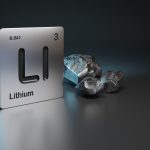McLeod, Texas rarely makes the news, but in March of this year, Standard Lithium announced it tested North America’s highest certified lithium grade brine from a sample taken from a repurposed oil well outside McLeod. This announcement ramped up exploration in the area and led some to speculate East Texas might soon experience another “boom,” but this time because of lithium.
Many of you reading this probably would be hard pressed to locate McLeod or Cass County on a map. Here’s a hint, wherever you’re thinking it might be, you’ll probably need to look east of that. The area sits atop the Smackover Formation, a geological formation that runs underneath an area that begins in far Northeast Texas and runs to the Florida panhandle. In the 1920’s, oil was discovered in the Smackover Formation, which led to a brief boom locally, but the formation requires deep wells (15 to 17 thousand feet deep). By comparison, the wells in the East Texas Field in Gregg, Upshur, Rusk, and Smith Counties were about 3,500 feet deep. Recently companies have begun exploring brine water in the Smackover Formation for the potential to extract lithium.
What’s so special about lithium from the Smackover Formation? Why is it a big deal?
Until recently, lithium extraction involved one of two methods, either (1) mining from hard rock, which occurs almost exclusively in Nevada or (2) evaporative mining, which involves evaporating brine in massive pools, such as those found in South America, leaving concentrations of lithium behind. Both methods have proven to be time-consuming and also have an adverse impact on the land and environment. Meanwhile, demand for products using lithium batteries continues to rise, while supplies have struggled to keep pace.
Recently, several companies have begun experimenting with a process known as direct lithium extraction (“DLE”), which promises to be both more efficient and cause fewer, if any, of the adverse effects on the soil and groundwater.
Lithium brine is a concentrated solution of water and the mineral lithium found in underground deposits. DLE technologies draw lithium out of brine using filters, membranes, ceramic beads, or other equipment. Currently, companies employ three different DLE applications: (1) adsorption; (2) ion exchange, and (3) solvent extraction, while other methods are being tested and developed. The higher the grade of lithium, the more efficient the DLE process. Overall, market analysists anticipate that lithium production from DLE technology globally will increase from 54,000 metric tons currently to 647,500 metric tons by 2032.
The two biggest players to date are Lilac Solutions, backed by Bill Gates and BMW, and Standard Lithium, a Canadian company backed by Koch Industries. Of the two, only Standard Lithium is currently operating in East Texas. Recently, Exxon began operations in Southwest Arkansas and it appears that Schlumberger is beginning to explore in Northeast Texas under the names SLB New Energy; ETNR Operating, LLC; and ETNR, LLC.
Standard Lithium operates a DLE Demonstration Plant in Southwest Arkansas, but its presence in East Texas is still speculative. It has conducted geological testing in East Texas, but all of the samples they have tested in the area come from the one repurposed oil well outside McLeod.
So who owns the lithium?
Well, that depends.
In Texas, a fee simple landowner may sever the “surface estate” and the “mineral estate,” so often a tract of land has both surface and mineral owners and any company wanting to produce lithium from brine will need to contract with the proper party. Additionally, the fee simple landowner can sever the “groundwater estate,” further complicating the matter.
While we have over 100 years of case law to give us clear direction on oil and gas leases, brine leases are completely new territory for Texas courts. In Texas, the surface owner owns the groundwater, which the Water Code defines as “water percolating below the surface of the earth.” Tex. Water Code § 35.0029(5). Texas courts treat groundwater differently than produced water, which courts consider to be “oil and gas waste.” Produced water belongs to the mineral estate, so arguably it depends on whether the water is extracted as part of oil & gas production or independent of oil & gas production.
Most landmen operating in East Texas seem to believe that, assuming that the groundwater estate has not been severed, the surface estate is the proper party from which to take a brine lease. These landmen work for companies that mine just the brine water, extract the lithium, and then pump the water back into the ground. Other companies have sought to get the mineral estate to enter into an oil, gas, and brine lease that would extract the lithium from produced water.
What do I need to know before signing a brine lease?
A property owner should always consult with an oil, gas, and mineral attorney prior to leasing any part of their estate. This applies to brine leases as well.
Folks that draft mineral leases have many fine qualities, but few ever mastered the art of writing with clarity. Indeed, perhaps no other legal document runs afoul of the rules of modern grammar (and some might say common decency) as the mineral lease. Antiquated phrasing creates long clunky paragraphs. Plus, by no accident, the folks that draft the leases use the smallest font possible and use terms of art that could easily lead a potential lessor astray.
Besides bad grammar and formatting, mineral leases proposed by lessees often try and sneak language past what they perceive to be unsophisticated lessors.
For example, before any large scale DLE production begins in Cass County or East Texas, there will need to be infrastructure in place to perform the DLE. The companies taking leases in Cass County have added language that allows them to enter into a lease today and extend it out past the primary term for several years (20+ years in some cases), which speaks to the speculative nature of this venture. The production companies would like to lock up the land, so that when the infrastructure is in place and as the technology improves, they can begin drilling operations.
Since part of the brine mining process involves injecting water back into the ground, some companies may try and sneak language into leases that would allow them to reap the benefits of carbon capture, enhanced oil recovery, or otherwise use the surface owner’s pore space. A potential lessor should be aware of everything a lessee is injecting into the ground for a number of reasons and if it is anything other than the recycled brine water there should be additional consideration.
As always, we are here to help you with all of your mineral needs, including lithium and brine leases. If you have any questions about the emerging world of lithium or if you need guidance in evaluating a brine lease, please do not hesitate to contact us.

 Coghlan Crowson, LLP is a law firm based in Longview, Texas that provides a full range of legal services throughout Texas and Arkansas. The law firm has earned a reputation for providing excellent legal services in complex matters at rates that result in real value for its clients.
Coghlan Crowson, LLP is a law firm based in Longview, Texas that provides a full range of legal services throughout Texas and Arkansas. The law firm has earned a reputation for providing excellent legal services in complex matters at rates that result in real value for its clients. 







0 Comments